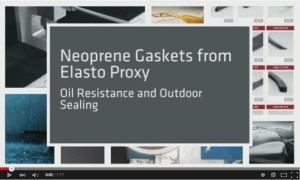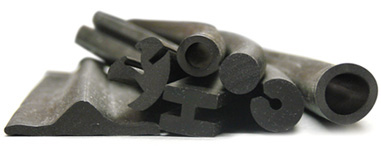
Neoprene gaskets are made of oil-resistant elastomers that also provide weather resistance and environmental sealing. Learn more about neoprene rubber’s applications and advantages, and how finished neoprene gaskets are custom-fabricated from standard neoprene profiles.
Neoprene gaskets provide resistance to oils, greases, and waxes; oxidation and ozone; and weathering and water immersion. A type of synthetic rubber (SR), neoprenes are a large family of elastomeric materials that are available in various types or grades. Some are compounded with EPDM or NBR to impart specific properties. Chemical, temperature, and flame resistance varies by neoprene compound, but neoprene rubber is generally known for its oil resistance and use in outdoor applications.
Neoprene Compounds for Elastomeric Gaskets
Design engineers who specify elastomeric materials need to understand neoprene rubber’s advantages and applications. Industrial buyers also need to know that many different types of neoprene profiles are available. Compounders offer solid neoprene compounds in various stock forms, but an off-the-shelf product may not solve your sealing challenge. By working with a custom fabricator who understands your application requirements, you can source finished neoprene gaskets that meet all of your needs.
Neoprene Rubber Advantages
Neoprene has good dynamic properties, ages well, and does not readily soften when exposed to heat. Although neoprene is a good choice for soft, high-strength compounds, this synthetic rubber cannot match the low-temperature flexibility of natural rubber. Ultimately, however, neoprene’s outstanding resistance to oils and greases, and the availability of neoprene grades with a maximum temperature resistance of 250° C, are what make neoprene gaskets right for industrial applications.
Neoprene Gasket Applications
Neoprene gaskets can be used for either static or dynamic sealing. Neoprene seals for static applications are used in stationary applications between two mating surfaces. When used as dynamic seals, neoprene gaskets create a barrier between moving and stationary surfaces to retain or separate fluids, prevent the ingress of contaminants, and contain pressure. In addition to door gaskets and window seals, industrial applications for neoprene gaskets include pump impellers and hydraulic systems.
Standard Neoprene Profiles

Neoprene rubber can be extruded into standard profiles for subsequent custom-fabrication. Suppliers extrude sponge or solid neoprene rubbers into specific shapes and sizes, and with different degrees of hardness (durometer). Both open cell and closed cell sponge materials are available, and some of these neoprene compounds have a UL-94 flame rating. Standard types of neoprene profiles include C-channels, E-strips, J-seals, round and square cords, P-channels, U-channels, quad, strips, and zipper strips.
Custom Neoprene Gaskets
Neoprene profiles can be cut-to-size via water jet cutting, a custom-fabrication technique that produces fine, fast cuts without long lead times or tooling charges. The non-beveled edges that water jet cutting creates are easy to join via film splicing, cold bonding, C-press, injection, molding, or vulcanizing. Taped neoprene gaskets that are ready-to-install are also available. For outdoor applications, 3M’s heat activated taping system (HATS) is a good choice because HATS has strong weatherstripping capabilities.
From Compound Selection to Custom Fabrication
Is neoprene rubber the right choice for your industrial sealing application? Do you need neoprene gaskets that are made of solid or sponge rubber – and do you need a specific blend? What about dimensions and durometer? When you find the neoprene profiles you want, how will you fabricate the gaskets? In-house production may seem like the right choice, but have you considered all of your costs? Elasto Proxy is ready to help you answer these questions.
Download the Compound Selection E-Book to learn how to choose the right rubber for your application.

Download the Make It or Buy It? E-Book to learn about the business case for custom fabrication.

I hope you’ll find these resources to be helpful.
 Clyde Sharpe
Clyde Sharpe
General Manager at Elasto Proxy









